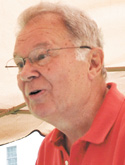Undecided voters play decisive role this election

SEE ALSO: Tea Party Express to have rally in Canfield
EDITOR'S NOTE: The NewsOutlet.org will follow eight undecideds for the next several weeks, Read all 8 stories on thenewsoutlet.org. Watch for stories in The Vindy over the next few weeks up till the election.
TheNewsOutlet.org
Nov. 6 could be the first time Larry Warren, 68, of Poland votes for a Democratic president.
Small-business owner Brian Brown, 27, of Carrollton juggles a side job and $133,000 in student loan debt. Wielding a political science degree, Brown said the presidential election frames the federal government’s role, the future of the economy and the American dream.
And Jodie Jacobson dodges political questions to avoid offending her customers at a produce stand in Liberty. She refuses to vote for President Barack Obama, but that doesn’t make voting for Mitt Romney any easier.
These likely Ohio voters make up the handful who, according to political experts and polling results, could determine the next president of the United States.
With the eyes of the nation closely watching swing states from Colorado to Florida, GOP nominee Mitt Romney and President Barack Obama battle for Ohio’s 18 Electoral College votes, the second highest number of any swing state.
And with neither candidate gaining in the polls, it may be the undecided voters who tip the scales in the November general election.
Most election polls have placed Obama and Romney under the 50-percent mark needed to rake in Ohio’s winner-take-all electoral votes, says Paul Sracic, chairman of the department of political science at Youngstown State University.
“The myth in Ohio is that there are a lot of undecided voters,” Sracic said. “That’s not the case.”
That faction is actually quite small, polls indicate.
An August poll from the Columbus Dispatch deadlocks Romney and Obama at 45 percent of the vote for each candidate, but it’s the remaining 10 percent who will “probably” decide the election, Sracic says.
Undecided voters vary in age, income level, gender, race, voting history and a myriad of other demographics. They also split on issues, though most voiced concerns about a do-nothing government stifled by a legislative stalemate and polarized comments.
Many, like 60-year-old Joe Sullivan of Boardman, are simply put off by the political subterfuge.
“Instead of saying what I’m going to do, it’s what the other guy didn’t do,” said Sullivan of what he hears on TV and reads in newspapers.
Instead of talking about the future of health care, the solvency of Social Security, the national debt his grandson will carry or other relevant issues, the candidates talk of tax returns and birth certificates, he said.
Warren shares the sentiment.
A Republican voter for the past 47 years who is now undecided, he reminisces about the moderate presidency of Dwight Eisenhower. Warren, a semi-retired educator and administrator, said the political divide hasn’t been this wide since Ronald Reagan’s two-term presidency in the 1980s.
He voted for Reagan and Eisenhower, but that doesn’t mean he’ll be voting for Romney.
“I’m not sure I’m going to vote Republican in November, to tell you the truth,”
Warren said on a rainy day at a farmers market in Poland, “I’m getting a little disenfranchised from my party. And if I would ever leave, I would say I didn’t leave the party, the party left me.”
Others have left behind all interest in the election.
Kathleen Chicoine, 51, usually attends presidential rallies when the campaign buses sweep into town. But the special education teacher refused to drive into Akron from her home in Cuyahoga Falls to see Obama over the summer.
Chicoine embodies an apathy for the political process that many undecided voters voiced.
“They sort of long for somebody who is in the middle. And they maybe long for a time where politics took place between the 30-yard lines,” Sracic said. “That doesn’t seem to be the case anymore.”
Neither candidate was heavily favored in his primary, Sracic said. But an eight to 10 percent margin of undecided voters isn’t historically uncommon.
But the tight presidential race puts added emphasis on Ohio’s toss-up voters.
“That’s why these voters carry so much weight,” Sracic said. “It may be only a small percentage … of voters in Ohio who are going to determine where 100 percent of Ohio’s vote goes in November.”
TheNewsOutlet.org is a collaboration among the Youngstown State University journalism program, Kent State University, University of Akron and professional media outlets, including WYSU-FM Radio, The Vindicator, and The Beacon Journal and Rubber City Radio, both of Akron.
 43
43
